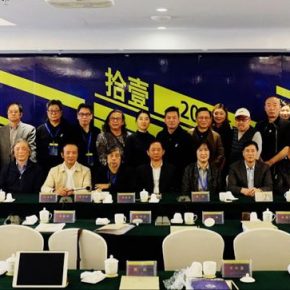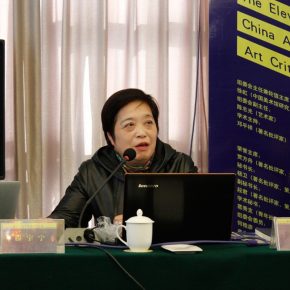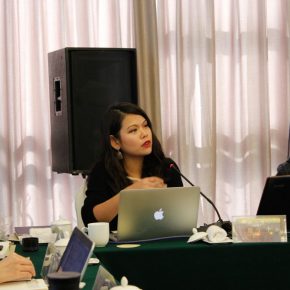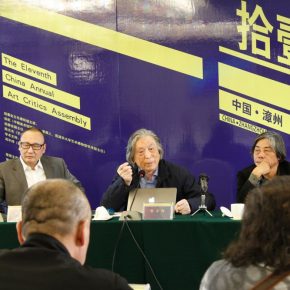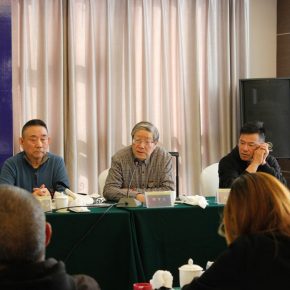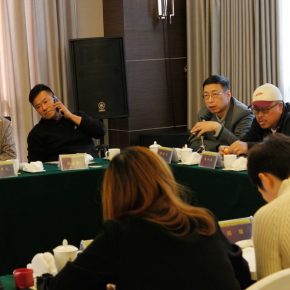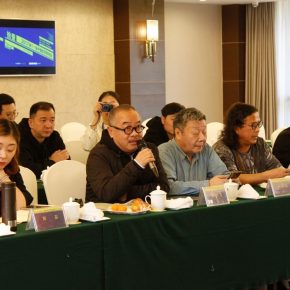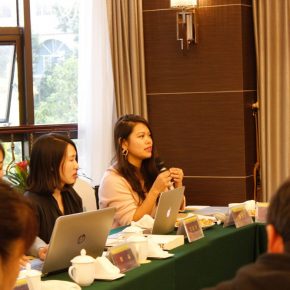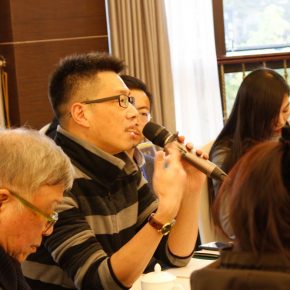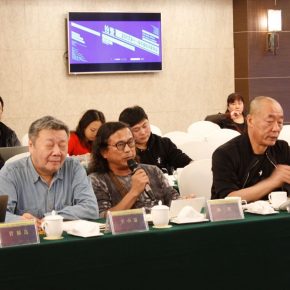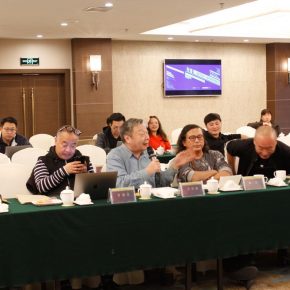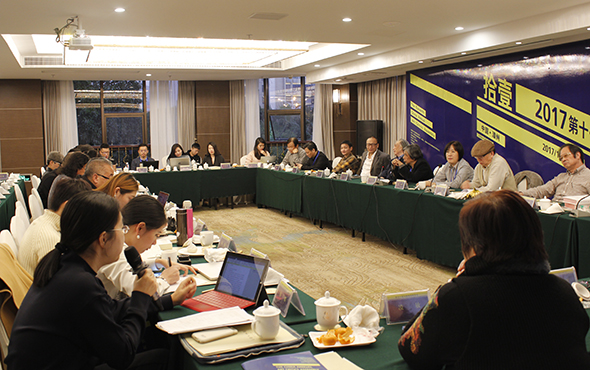
From December 20 to December 22, 2017, the 11th Annual Conference of Chinese Art Critics was held in Zhangzhou, Fujian Province, gathering the art critics from all over the country, to explore the status quo and future of Chinese art criticism for the development of Chinese contemporary art. Liu Weize, Member of the Standing Committee of Zhangzhou, Minister of the Publicity Department, delivered a speech at the 11th Annual Conference of Chinese Art Critics, on December 20, and he said that the 11th Annual Conference of Chinese Art Critics was held in Zhangzhou, which promoted the development of Chinese contemporary art in Zhangzhou, and also combined the geo-culture to bring a new opportunity to contemporary Chinese art criticism.
The annual conference was themed on “Seeing and Reading: Critics and Readers”, with three sub-topics: “Reading Theory and Contemporary Chinese Art Criticism”, “Identity, Ethnicity, Gender and Criticized Reading”, “Critics and Readers”. The openness of contemporary art makes it possible to interpret texts in different ways and with different answers. It is more difficult for readers to find clear guidelines to understand and recognize the advantages and disadvantages of contemporary art than traditional art. Artists gave the option to the audience, and critics establish a dialogue between both. Compared with the previous conferences, more young scholars and female scholars attended this conference, so that the discussion was profoundly and broadly carried out, revealing both a solid academic standard and a young & diverse perspective.
Four Keynote Reports Direct Criticisms of Contemporary Chinese ArtWang Lin, Professor of Sichuan Fine Arts Institute, PhD supervisor of Xi’an Academy of Fine Arts and a critic, Ma Qinzhong, art critic and curator, Ling Min, Associate Professor at the College of Fine Arts at Shanghai University and Vice Chairman of International Association of Art Critics, Teng Yuning, Deputy Secretary General of Wu Zuoren International Foundation of Fine Arts and Deputy Director of the Center for Visual Studies CVS, respectively delivered the keynote speeches on the morning of December 20 and the morning of December 21, and it was presided over by Rotating Chairman Xu Hong.
On the morning of December 20, Ma Qinzhong first gave a keynote speech entitled “Contemporary Art Criticism that ‘Invents’ the Artistic Significance”. Ma Qinzhong proposed the problems faced by Chinese contemporary art criticism: art criticism was reduced to “collusion” between critics and art to a certain extent with criticism being made to “invent” the meaning of works of art instead of criticizing.
Wang Lin delivered a speech entitled “How Did Alexandra Munroe Construct Chinese Contemporary Art? – Reading Yang Jiecang’s Text ‘Chinatown Exhibition’ – Reading ‘Art and China after 1989: Theater of the World’”, and he thought that Yang Jiecang’s article was full of “compliments” of Alexandra Munroe, and ignored the painstaking dedication of two generations of contemporary art critics in China. Wang Lin criticized such overseas institutions and curators who grasped the power of discourse of contemporary Chinese art and artists who belittled the contributions made by domestic critics.
On the morning of December 21, Ling Min introduced the situation of the International Association of Art Critics (AICA) from the perspective of historical origin and organizational structure. Ling Min believed that contemporary Chinese art critics, especially young art critics, should bring the superiority of language and information of the media era into full play, and more actively participated in the trend of international art criticism, so as to continuously improve the level of contemporary art criticism and contemporary art in China.
After Ling Min’s report, Teng Yuning delivered a speech reviewing the art criticism of the past year. First of all, she had a report on the survey of the archives of modern Chinese art in 2017, within this complicated information, she considered the “disagreement” and “differentiation” as the key words of Chinese contemporary art in 2017, to elaborate the problems, conflict and trends in the art circles in the past year. The words of “ink painting”, “video”, and “technology” frequently appeared in 2017, but the highlighted words were rarely discussed in the art circles.
Three Subjects, Critics Gathered to Discuss the Status Quo and Future of Chinese Contemporary Art CriticismOn the afternoon of December 20, critics had heated discussions on one subject and three sub-topics, and critic Deng Pingxiang was the moderator of the symposium. The discussion involved the discourse of criticism, critics and readers, the significance of criticism and data.
Who Does Control the Right of Discourse of Chinese Contemporary Art?Wang Lin delivered a keynote speech of “How Did Alexandra Munroe Construct Chinese Contemporary Art? – Reading Yang Jiecang’s text of ‘Chinatown Exhibition’ – Reading ‘Art and China after 1989: Theater of the World’” led to heated discussions among critics. Critics Chen Xiaoxin and Jia Fangzhou made it clear that the “main battlefield” of Chinese contemporary art was in China. But Pi Daojian believed that contemporary Chinese art was still marginalized in the international arena and he hoped that younger generations have more opportunities going to the international to promote contemporary Chinese art.
Yin Shuangxi, Yu Ke, Guan Yuda, LaoZhu and Gu Zhenqing offered constructive ideas of the building of the right of discourse of contemporary Chinese art. Yin Shuangxi believed that the criticism of contemporary art was also the game of capital and power. Yu Ke believed that it lacked a professional critic, curator or art museum mechanism in China. Guan Yuda said that it should avoid both the blind pursuit of the West, and the self-confidence. LaoZhu said that we should study the West, learning from the West, keeping up with the pace of social development, and lead the world with the art created by new media and new technologies. Gu Zhenqing thought that we needed self-criticism in the country and also needed to think of the professional in the international.
The two female scholars that presented at the scene put forward different opinions: Zhai Jing thought that it was a false proposition on how Chinese contemporary art criticism took place in the world. Ai Leier proposed that it could discuss the regional of art. Young critics such as Zheng Na, Ge Xiuzhi, Teng Yuning, You Jiang, Xu Shudong and Taiwan critic Zhang Lihao were all concerned about what the current art criticism was, in the context of new media and new technology.
The discussion on the significance of artistic criticism was triggered by Ma Qinzhong’s keynote speech entitled “Contemporary Art Criticism that ‘Invents’ the Artistic Significance”. Critics Yin Shuangxi and Wang Duanting both considered great critics that discover great artistic value, and Li Xiaofeng posed the bottom line for artistic criticism. Female scholar Qiu Min believed that artistic criticism was the combination of sensibility and rationality.
The importance of the carding of the materials, documents and archives of art criticism has also been mentioned by many critics who were present at the conference. Taiwan scholar Huang Haiming talked about Taiwan museums of fine arts that began to focus on the historical excavation, and exhibitions began to archiving. Zhang Guanghua believed that in the present era of big data, we emphasized the role of the internet information age. We touched the first-hand native information of the past, but now we treat the media-translated information, he asked how much did the translated data restore the original data? How should we treat the primary information in present society? These were questions worth considering and discussing.
After two days of enthusiastic thematic reports and academic discussions, the 11th Annual Conference of Chinese Art Critics closed on the morning of December 21. The 12th Annual Conference of Chinese Art Critics in 2018 will move to Shanghai, and Li Xiaofeng will serve as the rotating president.
Participants of the 11th Annual Conference of Chinese Art Critics (a total of 47 people, listed in no particular order):Chairman of Organizing Committee, Rotating Chairman, Moderator of Thematic Report: Xu Hong, Researcher and Curator of National Art Museum of China, Director of Department of Curatorial Research of Tsinghua University Art Museum
Deputy Director of the Organizing Committee: Artist Chen Zhiguang
Academic Chair and Seminar Moderator: Critic Deng Pingxiang
Moderator of the Opening: Yang Wei, Secretary General of the Annual Conference of Chinese Art Critics
Members of the Annual Conference (29 persons): Jia Fangzhou, Yang Wei, Xu Hong, Deng Pingxiang, Pi Daojian, LaoZhu, Wang Duanting, Yin Shuangxi, Ge Xiuzhi, Guo Hongmei, Ai Leier, Tan Wei, Qiu Min, Li Xiaofeng, Ma Qinzhong, Guan Yuda, Yang Xiaoyan, Wang Lin, Wang Xiaojian, Chen Xiaoxin, Yu Ke, Chen Mo, Liu Chun, Teng Yuning, Zheng Li, Zhang Guanghua, Zheng Na, You Jiang
Special Guests (3 persons): Gu Zhenqing, Zhai Jing, Ling Min
Scholars from Taiwan (4 persons): Huang Haiming, Zhang Lihao, Shi Ruiren, Huang Qianfang
Scholars from Fujian (11 persons): Chen Zhiguang, Li Yumin, Wu Yiyu, Xu Dongshu, Tang Yuebin, Cai Sencheng, Lan Dawen, Yang Tiansheng, Wang Yancheng, Lin Yumei, Li Haimei
Text and photo by Zhong Yuwei, translated by Chen Peihua and edited by Sue/CAFA ART INFO


